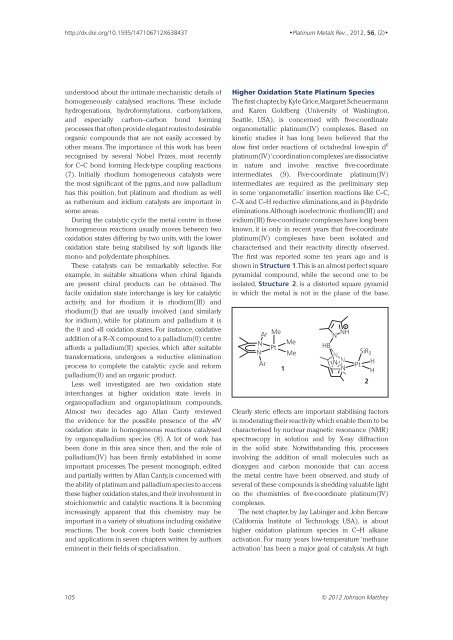Download article PDF - Platinum Metals Review
Download article PDF - Platinum Metals Review
Download article PDF - Platinum Metals Review
You also want an ePaper? Increase the reach of your titles
YUMPU automatically turns print PDFs into web optimized ePapers that Google loves.
http://dx.doi.org/10.1595/147106712X638437<br />
•<strong>Platinum</strong> <strong>Metals</strong> Rev., 2012, 56, (2)•<br />
understood about the intimate mechanistic details of<br />
homogeneously catalysed reactions. These include<br />
hydrogenations, hydroformylations, carbonylations,<br />
and especially carbon–carbon bond forming<br />
processes that often provide elegant routes to desirable<br />
organic compounds that are not easily accessed by<br />
other means. The importance of this work has been<br />
recognised by several Nobel Prizes, most recently<br />
for C–C bond forming Heck-type coupling reactions<br />
(7). Initially rhodium homogeneous catalysts were<br />
the most significant of the pgms, and now palladium<br />
has this position, but platinum and rhodium as well<br />
as ruthenium and iridium catalysts are important in<br />
some areas.<br />
During the catalytic cycle the metal centre in these<br />
homogeneous reactions usually moves between two<br />
oxidation states differing by two units, with the lower<br />
oxidation state being stabilised by soft ligands like<br />
mono- and polydentate phosphines.<br />
These catalysts can be remarkably selective. For<br />
example, in suitable situations when chiral ligands<br />
are present chiral products can be obtained. The<br />
facile oxidation state interchange is key for catalytic<br />
activity, and for rhodium it is rhodium(III) and<br />
rhodium(I) that are usually involved (and similarly<br />
for iridium), while for platinum and palladium it is<br />
the 0 and +II oxidation states. For instance, oxidative<br />
addition of a R–X compound to a palladium(0) centre<br />
affords a palladium(II) species, which after suitable<br />
transformations, undergoes a reductive elimination<br />
process to complete the catalytic cycle and reform<br />
palladium(0) and an organic product.<br />
Less well investigated are two oxidation state<br />
interchanges at higher oxidation state levels in<br />
organopalladium and organoplatinum compounds.<br />
Almost two decades ago Allan Canty reviewed<br />
the evidence for the possible presence of the +IV<br />
oxidation state in homogeneous reactions catalysed<br />
by organopa lladium species (8). A lot of work has<br />
been done in this area since then, and the role of<br />
palladium(IV) has been firmly established in some<br />
important processes. The present monograph, edited<br />
and partially written by Allan Canty, is concerned with<br />
the ability of platinum and palladium species to access<br />
these higher oxidation states, and their involvement in<br />
stoichiometric and catalytic reactions. It is becoming<br />
increasingly apparent that this chemistry may be<br />
important in a variety of situations including oxidative<br />
reactions. The book covers both basic chemistries<br />
and applications in seven chapters written by authors<br />
eminent in their fields of specialisation.<br />
Higher Oxidation State <strong>Platinum</strong> Species<br />
The first chapter, by Kyle Grice, Margaret Scheuermann<br />
and Karen Goldberg (University of Washington,<br />
Seattle, USA), is concerned with five-coordinate<br />
organometallic platinum(IV) complexes. Based on<br />
kinetic studies it has long been believed that the<br />
slow first order reactions of octahedral low-spin d 6<br />
platinum(IV) ‘coordination complexes’ are dissociative<br />
in nature and involve reactive five-coordinate<br />
intermediates (9). Five-coordinate platinum(IV)<br />
intermediates are required as the preliminary step<br />
in some ‘organometallic’ insertion reactions like C–C,<br />
C–X and C–H reductive eliminations, and in -hydride<br />
eliminations. Although isoelectronic rhodium(III) and<br />
iridium(III) five-coordinate complexes have long been<br />
known, it is only in recent years that five-coordinate<br />
platinum(IV) complexes have been isolated and<br />
characterised and their reactivity directly observed.<br />
The first was reported some ten years ago and is<br />
shown in Structure 1. This is an almost perfect square<br />
pyramidal compound, while the second one to be<br />
isolated, Structure 2, is a distorted square pyramid<br />
in which the metal is not in the plane of the base.<br />
Ar Me<br />
N Me<br />
Pt<br />
N Me<br />
Ar<br />
1<br />
N NH<br />
HB<br />
N<br />
N N<br />
N<br />
Clearly steric effects are important stabilising factors<br />
in moderating their reactivity which enable them to be<br />
characterised by nuclear magnetic resonance (NMR)<br />
spectroscopy in solution and by X-ray diffraction<br />
in the solid state. Notwithstanding this, processes<br />
involving the addition of small molecules such as<br />
dioxygen and carbon monoxide that can access<br />
the metal centre have been observed, and study of<br />
several of these compounds is shedding valuable light<br />
on the chemistries of five-coordinate platinum(IV)<br />
complexes.<br />
The next chapter, by Jay Labinger and John Bercaw<br />
(California Institute of Technology, USA), is about<br />
higher oxidation platinum species in C–H alkane<br />
activation. For many years low-temperature ‘methane<br />
activation’ has been a major goal of catalysis. At high<br />
+<br />
SiR 3<br />
Pt<br />
H<br />
H<br />
2<br />
105 © 2012 Johnson Matthey
















